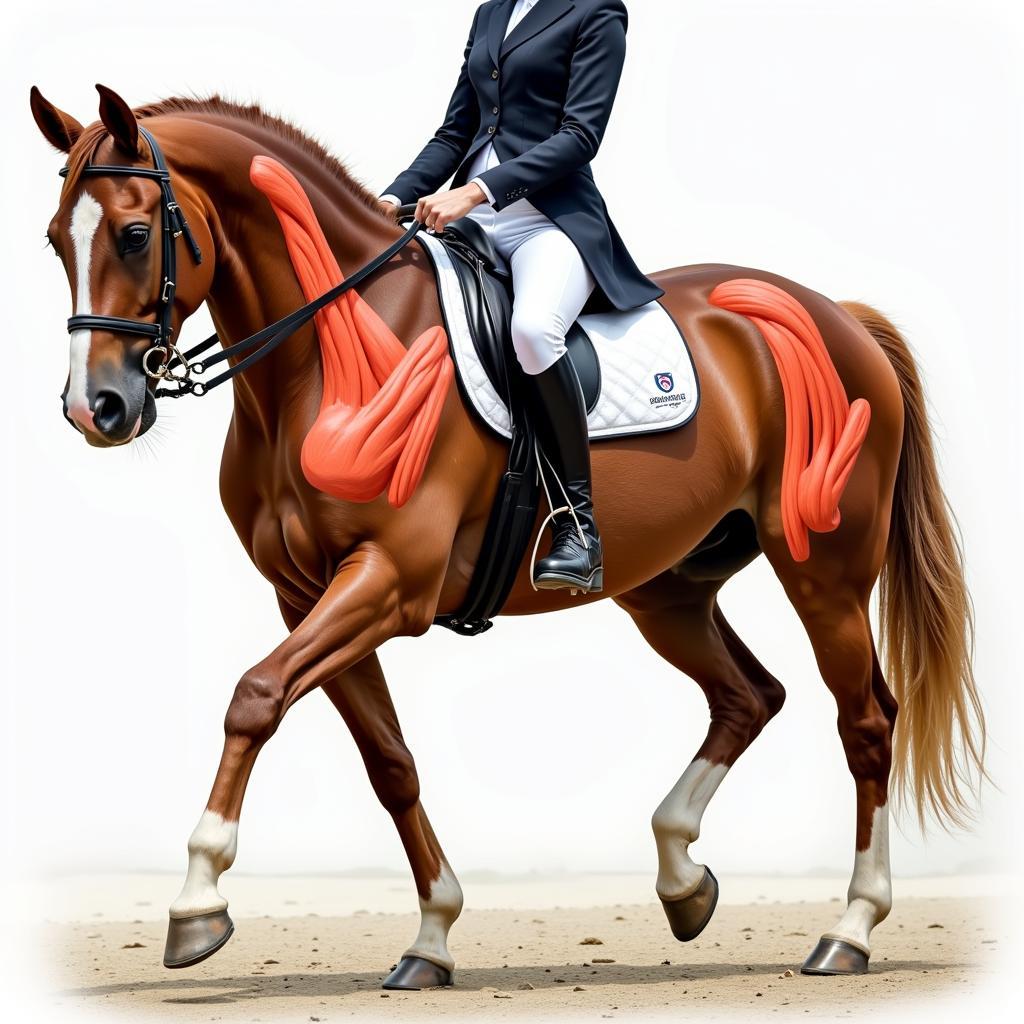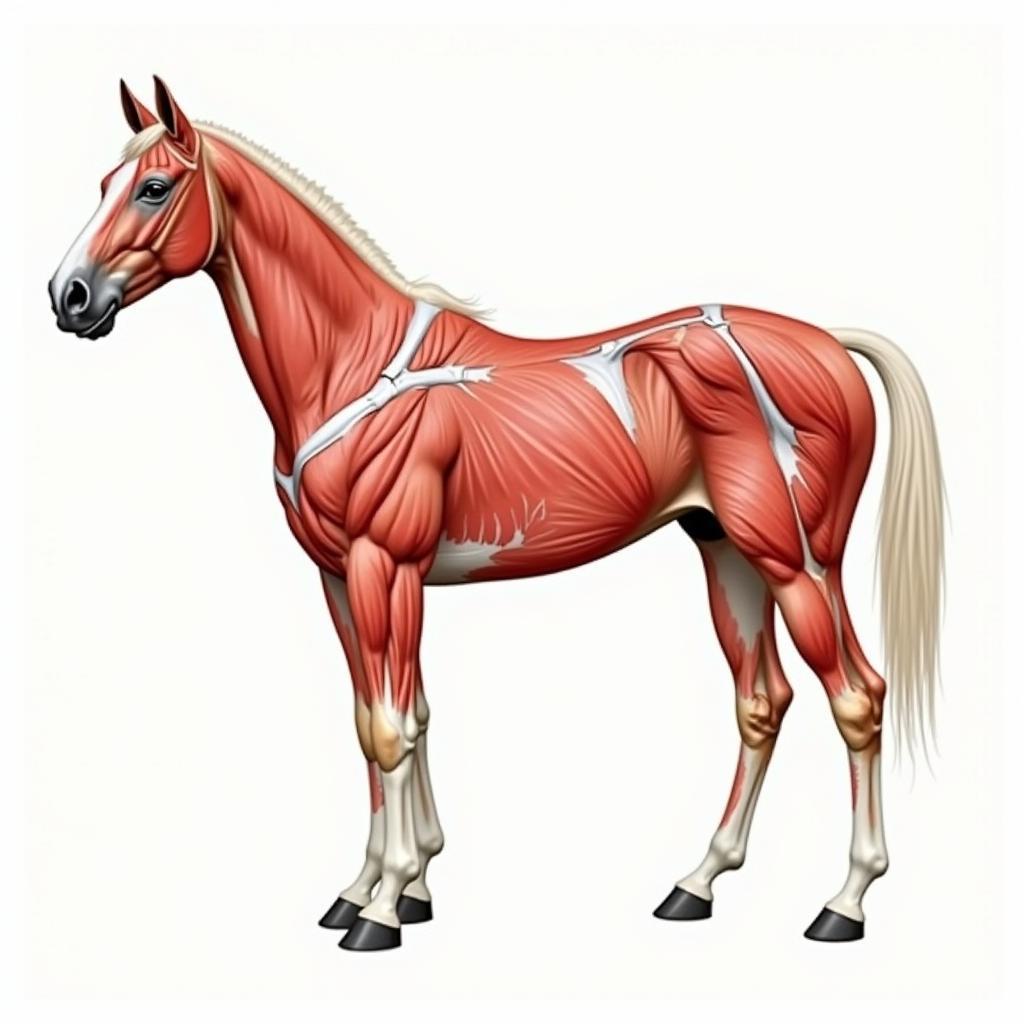The term “Bodybuilder Horse” evokes images of powerfully muscled equines, sculpted through dedicated training and meticulous care. While we don’t expect horses to pose on stage, achieving a strong, healthy physique is crucial for performance, longevity, and overall well-being. This article will delve into the art of building equine muscle, covering everything from tailored exercise regimes to optimal nutrition.
Understanding the Bodybuilder Horse Concept
Building muscle in horses isn’t about creating an exaggerated, unnatural look. It’s about developing the correct musculature for their specific discipline and ensuring they are physically capable of performing their tasks efficiently and safely. Whether it’s a dressage horse needing powerful hindquarters or a jumper requiring explosive strength, targeted training is key. A balanced approach focusing on proper conditioning, nutrition, and rest is essential for creating a “bodybuilder horse” in the truest sense.
Tailored Exercise Regimes for Equine Muscle Development
Different disciplines require different muscle groups to be developed. Long, slow distance work builds endurance and lean muscle, while interval training and hill work promote strength and power. Incorporating exercises like pole work, cavaletti, and dressage movements can also help target specific muscle groups and improve overall balance and coordination. Remember, consistency is key. Regular, progressive workouts are more effective than sporadic intense sessions.
 Dressage Horse Showing Powerful Hindquarters
Dressage Horse Showing Powerful Hindquarters
The Role of Nutrition in Building a Bodybuilder Horse
Just like human bodybuilders, horses require a balanced diet rich in protein, carbohydrates, and healthy fats to fuel muscle growth and repair. High-quality hay or pasture should form the foundation of their diet, supplemented with grains or concentrates as needed to meet their energy requirements. Adding specific supplements, such as amino acids and electrolytes, can further support muscle development and recovery. Consult with an equine nutritionist to create a feeding plan tailored to your horse’s individual needs.
Common Misconceptions about Bodybuilder Horses
One common misconception is that more muscle automatically equates to better performance. This is not always true. Excessive muscle mass can hinder agility and flexibility, increasing the risk of injury. Another misconception is that building muscle requires hours of intense exercise. Short, focused sessions combined with adequate rest are often more effective.
 Equine Muscle Anatomy Chart for Targeted Training
Equine Muscle Anatomy Chart for Targeted Training
Is Your Horse a “Hard Gainer”? Tips for Difficult Cases
Some horses naturally find it harder to build muscle than others, just like humans. These “hard gainers” may require a higher calorie diet, specialized supplements, or adjustments to their training program. Consulting with a veterinarian or equine nutritionist can help identify any underlying health issues and create a customized plan for optimal muscle development.
The Importance of Rest and Recovery
Muscle growth occurs during rest, not during exercise. Adequate rest is crucial for allowing muscles to repair and rebuild stronger. Overtraining can lead to muscle fatigue, soreness, and even injury, hindering progress rather than promoting it. Ensure your horse gets enough rest days, and incorporate activities like stretching and light turnout to aid in recovery.
What are the signs of overtraining in a “bodybuilder horse”?
Signs of overtraining include decreased performance, loss of appetite, stiffness, and general lethargy. If you notice these signs, reduce the intensity and duration of your horse’s workouts and consult with your veterinarian.
How long does it take to see muscle development in a horse?
The timeframe for visible muscle development varies depending on the horse’s age, breed, training program, and individual metabolism. Generally, you can expect to see noticeable changes within a few months of consistent training and proper nutrition.
Conclusion
Building a “bodybuilder horse” is about more than just aesthetics. It’s about developing a strong, healthy, and well-conditioned athlete capable of performing at its best. By focusing on tailored exercise, optimal nutrition, and adequate rest, you can help your equine partner achieve peak physical condition and enjoy a long and successful career. Remember, the key to success lies in a balanced approach, always prioritizing the horse’s well-being above all else.
FAQ
- What supplements can help with muscle building in horses? Supplements like amino acids, branch chain amino acids, and certain vitamins and minerals can be beneficial. Consult your veterinarian before starting any supplements.
- How often should a bodybuilder horse be worked? This depends on the horse’s age, fitness level, and discipline. Most horses benefit from 3-5 training sessions per week.
- Is hill work good for building muscle in horses? Yes, hill work is excellent for building strength and power in the hindquarters.
- What type of hay is best for a horse focused on muscle building? High-quality alfalfa hay is a good option due to its high protein content.
- Can overtraining hinder muscle development in horses? Yes, overtraining can lead to muscle fatigue, soreness, and injury, preventing optimal muscle growth.
- What are some signs of muscle soreness in horses? Signs of muscle soreness can include stiffness, reluctance to move, and sensitivity to touch.
- How important is proper warm-up and cool-down for a bodybuilder horse? Essential! Proper warm-up and cool-down are crucial for preventing injuries and promoting muscle recovery.
Need support? Contact us 24/7. Phone: 0772127271, Email: [email protected] or visit us at QGM2+WX2, Vị Trung, Vị Thuỷ, Hậu Giang, Việt Nam.